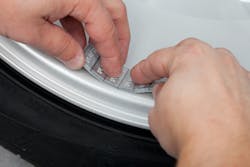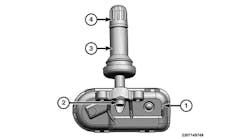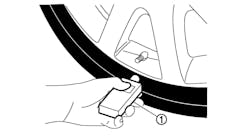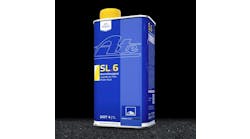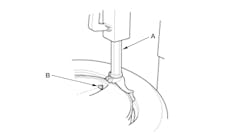Although clip-on wheel weights can outnumber adhesive wheel weights in tire stores, adhesive weights are growing in popularity and becoming a more important piece of a shop’s purchase goods.
Don Vanderheyden, director of marketing for Hennessy Industries Inc., manufacturer of Bada brand clip-style weights and adhesive wheel weights, estimates adhesive wheel weights make up about 40% of the aftermarket. Gregory Parker, national account sales manager and marketing director for North America at Wegmann automotive USA Inc., places the split at 35% adhesive weights and 65% clip-on weights. He acknowledges the use of adhesive weights versus the clip-on style in the aftermarket is increasing but cautions a rapid transition is not on the horizon.
“The market is always experiencing slow change,” Parker says. “For our segment of the industry the growth of adhesive weight usage is evident and is being driven by adhesive usage growth at the OEM level and the universal appeal of adhesive weight installation. But clip-on weights are not leaving the market anytime soon.”
The introduction of adhesive wheel weight automation in original equipment factories is contributing to the slow increase in adhesive weight usage as OEMs are slowly removing flanges from their rims altogether.
Wheel weight automation can feature standard steel segmented adhesive weights or continuous adhesive weights, made from composite materials, that are installed using robotic arms and large 300 to 400 pound rolls of product. Continuous adhesive weights are well-suited for automation and can be cut to the exact weight, within a fraction of a gram, necessary to balance a tire. However they are roughly two to three times more expensive than standard segmented steel adhesive weights.
There are several factors to consider when discussing the cost of wheel balance weights, according to Parker.
“Adhesive weights are typically lower in cost than clip-on weights for a few reasons,” he says. “Clip-on weights require more SKUs and are slightly harder to manufacture, which increase the cost. Adhesive weights are easier to manufacture and are higher output due to fewer SKUs, which help reduce the cost. However, adhesive weights and clip-on weights are all priced relative to their raw material (lead, zinc or steel) pricing, and both adhesive weights and clip-on weights have other factors like speed and efficiency to consider outside of cost when making decisions on what is right for the business.”
More accuracy Is required
The popularity of flangeless alloy rims is also pushing the use of adhesive weights upwards. Consumers do not want to see a wheel weight on the outside of the wheel. A clip-on weight can be placed on the inside flange, but the only option for the outside plane is an adhesive weight. Technicians can balance the wheel using clip-on weights and adhesive weights, or two adhesive weights.
“When you get rid of that outer clip weight for cosmetic reasons, the weight planes, or the separation between the two weights, are narrower,” says Greg Meyer, wheel balancer product manager at Hunter Engineering Co. “The best placement would be at the extreme inside and outside of the wheel.” The farther apart the weights, the more “couple” force, or the side-to-side wobble of a rolling tire, can be counteracted.
“We’ve lost the outside and two or three more inches because the weight has to be behind the spokes. When those weight planes get closer together, the amount of weights that are required goes up and the precision with which they’re placed also has to go up,” he says.
Adhesive weights require both the balancer and the technician to be more accurate. “He’s got to be more careful and more cautious or he runs the risk of having to peel them off and try again or doing a bad job and having an unhappy customer with a vibration complaint,” says Meyer.
One of the latest trends in custom wheels is extremely thin spokes that curve and blend into the barrel of the rim rather than stop at the barrel. The spoke style creates high and low spots in the rim, which complicates the balancing job for the technician. The design requires the weights to be placed just three or four inches apart.
“The weights would rapidly start getting very large and difficult to compensate for the imbalance,” says Meyer. “The trend is definitely there for the tire dealer and more so for the aftermarket people who are dealing with specialty custom rims. Sooner or later everyone is going to see some crazy example of this.”
Bigger wheels also create wheel weight challenges. Although bigger wheels should be easier to balance because they are wider and have larger diameters, consumers do not want to see the weights.
“The reality is that bigger wheels are more appearance-focused. There’s almost never an outer weight installed on a wheel larger than 20 inches because the guy buying 20-inch wheels would never allow it,” says Meyer.
Balancers evolve
Balancers have become more helpful to technicians. Advancements enable a technician to place the correct amount of clip-on or adhesive weight exactly where needed.
Meyer says Hunter’s patented SmartWeight technology gives technicians the simplest solution with the least amount of weights that are fastest to apply. The speed and simplicity of placing wheel weights are side benefits of SmartWeight. The technology provides a better overall balance by focusing on the up and down static forces that are most likely to be felt by the driver while keeping the couple (wobble) forces in check, adds Meyer.
Hennessy Industries’ Vanderheyden suggests dealers consider advances in technology that make it easier and faster to install wheel weights when purchasing new equipment. Features such as the ability to lock the wheel in place, lasers to pinpoint the weight’s exact location and lighting to illuminate the barrel of the wheel are available on advanced models such as the Coats 1600 wheel balancer.
The additional technologies make the balancing process easier, faster and more accurate, which helps offset the time and steps required to install adhesives weights compared to clip-on weights. In order for an adhesive weight to stick to the wheel, the area where it will be attached must be cleaned with a solvent and dried first, which adds time to do correctly. Clip-on weights do not require the wheel to be cleaned and are much faster to install.
Cleanliness counts
Advancements in balancing equipment allow technicians to be faster and more efficient when installing clip-on and adhesive weights. Other efficiency improvements are coming from wheel weight packaging and inventory management, according to Parker. He notes tire stores are becoming aware of a cleanliness standard that is used in manufacturing settings called 5S. The 5S organization method is a process designed to keep the workplace in a clean condition.
“Tire retailers in the 21st century are understanding that high-level shop efficiencies are necessary in order to compete in today’s competitive landscape. Inventory management systems, faster reordering tools, and 5S cleanliness standards help technicians worker smarter, not harder,” he says.
Wegmann’s Hofmann Power Weight brand has developed a racking system for wheel weight inventories that allows technicians to get to the product faster.
“We are introducing our Hofmann Power Weight SpeedRack, which delivers a wheel weight inventory solution that holds all the inventory in the shop, features front opening boxes to ensure a clean receptacle every time a new box is opened, and front mounted bar codes to make Warehouse Management System reordering easier,” says Parker. “It is no longer just about the weight, as suppliers must also enhance the offering surrounding the product itself.”
Ninth state bans lead
The use of lead wheel weights has been banned by nine states. The latest ban was passed by New Jersey in January 2018. The other states are Washington, Maryland, California, Illinois, Maine, Vermont, Minnesota and New York. Sources of lead-free wheel weight alternatives like zinc and steel include the Bada, Perfect Equipment, Plombco and Hoffman Power Weight brands. Plombco also offers a steel core wheel weight encased in a plastic shell called Plasteel. ■
